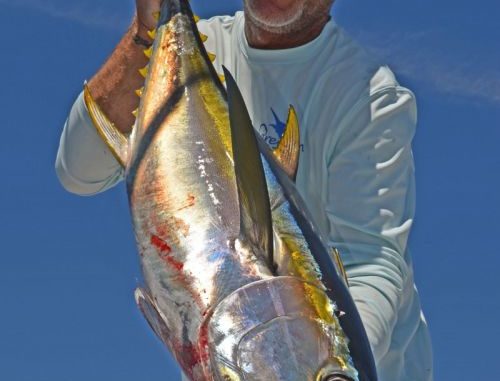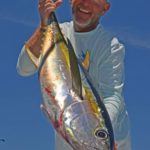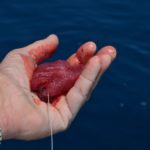
Hurricane Katrina devastated Port Eads in 2005, but the powerful storm didn’t do any damage to the world-class tuna fishing to be had to the south. And this captain shares the secrets to success.
I stood in the stern of Capt. Will Wall’s offshore charter boat, peering at the white buildings of Port Eads Marina etched against the early morning’s battery charged blue sky.
“So this is what it is now,” I silently thought to myself.
A public-use facility instead of the legendary home of the legendary New Orleans Big Game Fishing Club.
The exclusive club was formed in 1961 with 31 members under the leadership of New Orleans businessman Herman “Dutch” Prager. Membership in 1969-70 had grown to 123 members made up of the state’s social fishing elite, something only Louisiana could have produced in those days.
That year, 40 of the members were company presidents, nine were company vice-presidents, 21 were business owners, five were company general managers, three were company chairs of boards, 10 were attorneys and 15 were medical doctors.
The NOBGFC found a home at Port Eads in 1962 when the U.S. Coast Guard automated their lighthouse on the Mississippi River’s South Pass and turned their 328-foot wharf, warehouse and four cottages over to the Plaquemines Parish Commission Council on long-term lease.
The Perez family, which dominated the council, arranged for the fishing club to occupy one of the cottages, known as the “Number Four Building.”
The parish brought in two 17,000-gallon fuel tanks — one for diesel and one for gasoline — and an electrical generator, replaced five years later by a power line from Venice.
Within a couple of months, the Louisiana Land and Exploration Company dredged a harbor out of the marsh that could accommodate 24 fishing boats that were protected from the pass’ currents and away from ship’s wakes.
The NOBGFC held its first tournament out of Port Eads in July 1962.
Then, in August 2005, Hurricane Katrina struck with all its fury. Its violent winds and smashing storm surge obliterated everything but the stubborn 105-foot lighthouse.
For years it stood as a lonely sentinel in a sea of roseau canes, just as it had for 124 years before the storm.
But the night before this trip, I slept in the new Port Eads.
With Wall on the boat were his cheerful young deckhand, Alan Ballavares from Metairie, and two Port Eads Marina stalwarts: part-time manager Scott Pelas, and bait manager and fishing coordinator Tony Bruce.
Walls (Pelagic Charters, 225-454-5365) is no novice at this tuna gig, with 10 years under his belt. The slender Baton Rouge native looked like an old salt, with his closely cropped beard and shaved head.
The first order of business, he announced, was getting live bait. That meant pogies — not the little ones used for speckled trout fishing, but big 6- to 8-inch ones.
Wall ran the boat out of South Pass into the Gulf and to near the beach in the Garden Island area between South and Northeast passes.
In the early morning calm, it was easy to see schools of the fish flicking on the water’s surface.
When waves ruffle surface waters, making the schools harder to spot, Wall uses his depth sounder to find the baitfish.
Sneaking up on spooky schools in these calm conditions demanded some skill on Wall’s part. Using only one of his three 300-horsepower engines and with his depth sounder turned off, he pointed the slow-moving boat’s bow toward a school, and then turned it off and let the boat’s momentum carry it into the fish.
Standing on the bow, Ballavares expertly threw a big 9-foot cast net over the fish, and emptied the catch directly into the livewell on the stern of the boat.
Several other tuna skippers were also in the area, loading up with bait for the day.
Bait wells full, the skipper headed the boat south toward blue water. Twenty-two miles out of South Pass, in 2,300 feet of water, he throttled back at Mississippi Canyon 243-A, a rig he simply called “Elf.”
As soon as the boat stopped, Ballavares shook his head at the lack of visible current. Still, they deemed it worth a try.
A pogie hooked through the back was tossed overboard, and Ballavares hand-over-handed line out 75 yards before running it up an outrigger.
This line was followed by a second one on the other side of the boat.
Running all three engines at low rpms, Wall slowly meandered the boat in circles on the upcurrent side of the big oil-and-gas structure by shifting the engines in and out of gear, a process called “bump trolling.”
With the baits out, Wall bemoaned the lack of current over and over.
“Tuna are like speckled trout,” he said to noted speckled trout angler Bruce. “You have to have current to get a bite.”
The anglers could see tuna slow-rolling at the surface, but nothing produced bites. Even the liberal tossing of “freebies” — live, unhooked pogies — behind the boat men didn’t entice the tuna to the surface nor trigger feeding.
“We’ve got to move,” Wall finally said. “Our baits will die in this blue water in four or five hours.”
Ballavares explained to Pelas and Bruce that pogies are green-water fish and will live all day in green water, but that the high-salinity blue water being pumped through the bait wells will kill them.
The water here was blue, blue, blue.
Next stop was due east of the last rig: Vioska Knoll 989, a fixed platform set in 1,290 feet of water.
“You see current?” Ballavares asked Wall.
“Yeah,” the captain replied.
“Good, good, good,” Ballavares responded.
The pair quickly set out two lines, one with the pogie hooked through the back, the other with the bait hooked in the nose, and began bump trolling.
“Com’on, com’on,” Wall murmured.
A peek at Wall’s fish finder screen showed large numbers of tuna beneath the boat.
“Those are all yellowfin,” Wall grunted.
Other boats’ crews were seeing them, too. Eight boats were clustered upstream of the rig.
“The fish are here,” Wall said. “I can’t believe the baits have lasted this long.”
Several fish boiled behind the boat before a modest 30-pound yellowfin blew up on a trolled bait.
Youthful and athletic, Pelas made short work of that fish.
Walls and Ballavares worked hard to get more action, continually tossing live pogies ,and picking up and resetting lines.
Setting a line was a lot of work.
Ballavares would hook the bait and drop it in a bucket of water to keep it alive.
He would then strip out 20 to 30 yards of line, and then toss the hooked bait out to the length of the line, followed by even more line stripping to let the line out to proper trolling distance.
At 10:50 a.m. another tuna struck — this one bigger than the first.
Bruce whipped it.
Then at 11:20 a.m. another one, followed by yet another one at 11:30 a.m.
Each one was bigger than the last.
“No-current situations like this make high bait demands,” Wall complained over his shoulder while he tossed live pogies. “When you have good current, you can make the day with 30 pogies. A day like today, you need a couple hundred to feed the fish.”
Out of pogies, Wall decided to try some chunking to finish the day up.
Ballavares expertly carved out the belly of the smallest yellowfin in the box and cut it into 2-inch pieces.
He hid the 7/0 circle hook in a chunk by pushing it, bend first, into the flesh, completely hiding the hook. With the boat stopped to allow a natural drift of the bait, Ballavares told Pelas and Bruce to throw a couple of pieces of chum over the side, followed by gently dropping the chunk with the hook in the water.
He instructed the pair to slowly and steadily strip line from the reel to allow the bait to drift naturally down with the free chum.
Wall cautioned the two men not to let their line get tight, as doing so would pull the hook free from the bait.
If anything, this was more exciting than bump trolling live baits. When a tuna took the hook, the line instantly snapped from the angler’s hands so violently that it was scary.
With every strike, Wall went into coach mode.
“Don’t jerk! Don’t jerk!,” he said. “Reel down and lift up. Reel down and lift up.”
After his first chunk tuna, Bruce decided he had had all the fun he could handle in one day and retired to the shade under the boat’s T-top.
A few fish later, Pelas joined him.
Grinning — but without saying a word — Wall turned the bow of the boat toward Venice and home.


